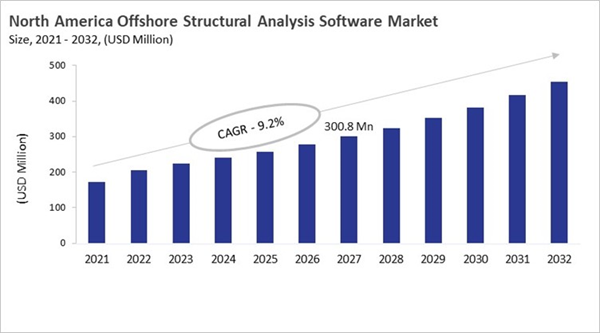The US market dominated the North America Offshore Structural Analysis Software Market by country in 2024, and is expected to continue to be a dominant market till 2032; thereby, achieving a market value of $323.3 Million by 2032. The Canada market is experiencing a CAGR of 10.9% during 2025-2032. Additionally, the Mexico market is expected to exhibit a CAGR of 9.5% during 2025-2032. The US and Canada led the North America Offshore Structural Analysis Software Market by Country with a market share of 75.2% and 10.4% in 2024.
The North American offshore structural analysis software market has grown from simple finite-element tools to fully integrated, lifecycle-oriented platforms that can be used for both traditional oil and gas infrastructure and new offshore wind projects. This change is due to stricter rules, deeper water problems, and more complicated designs. Advanced tools now include coupled hydrodynamic, aerodynamic, mooring, and soil-structure simulations. These tools can be used for everything from initial design and fatigue analysis to planning inspections and monitoring assets in real time. The recent growth of offshore wind, especially floating wind in U.S. waters that are prone to hurricanes, has sped up the need for multiphysics capabilities, digital twin integration, and high-fidelity modeling that works in different weather conditions.
The merging of wind and oil & gas toolsets is a big trend in the market. This lets engineers work in different fields using the same modeling framework. Digital twins are also becoming more popular for managing structural integrity all the time. Regulatory bodies and national labs now require workflows that can be checked and verified, which forces vendors to provide simulations that can be traced back to formal standards. Market leaders do well by having a wide range of technical skills, strong credentials for validating their work, and service-based offerings that cover the entire asset lifecycle. There is still a lot of competition. Legacy platforms are still the best choice for oil and gas projects that have a lot of rules to follow. Newer companies are pushing the envelope in cloud-based modeling, real-time analytics, and risk-based maintenance for both old and new offshore assets.
Deployment Model Outlook
Based on Deployment Model, the market is segmented into On-premise Licensing, and Cloud / SaaS. The On-premise Licensing market segment dominated the Canada Offshore Structural Analysis Software Market by Deployment Model is expected to grow at a CAGR of 10.7 % during the forecast period thereby continuing its dominance until 2032. Also, the Cloud / SaaS market is anticipated to grow as a CAGR of 11.2 % during the forecast period during 2025-2032.End-use Industry Outlook
Based on End-use Industry, the market is segmented into Oil and Gas, Offshore Wind, Marine and Naval, and Wave and Tidal Energy. Among various US Offshore Structural Analysis Software Market by End-use Industry; The Oil and Gas market achieved a market size of USD $94.3 Million in 2024 and is expected to grow at a CAGR of 7.1 % during the forecast period. The Marine and Naval market is predicted to experience a CAGR of 8.6% throughout the forecast period from (2025 - 2032).Country Outlook
The United States is the largest and most advanced market for offshore structural analysis software in North America, driven by deepwater oil and gas operations in the Gulf of Mexico and a rapidly expanding offshore wind sector on the East Coast. High-fidelity software is essential for modeling fixed and floating platforms, subsea systems, and wind turbine foundations under complex environmental conditions such as hurricanes and strong currents. Regulatory compliance with agencies like BSEE and ABS, combined with the scale and technological demands of offshore projects, has accelerated adoption of advanced tools featuring multi-physics simulations, digital twin integration, and predictive maintenance capabilities. Trends include cloud-enabled collaboration, AI-driven risk assessment, and lifecycle modeling to support sustainability goals and optimize operational efficiency. Competition is strong, with global OEMs, niche players, and tech-driven firms offering solutions differentiated by solver performance, regulatory traceability, and full-lifecycle support. Vendors with local expertise, strong partnerships, and integrated toolchains are best positioned to serve the U.S. market’s evolving offshore energy landscape.List of Key Companies Profiled
- Bentley Systems, Inc.
- ANSYS, Inc.
- Siemens AG
- DNV AS
- Autodesk, Inc.
- Ramboll Group A/S
- John Wood Group PLC
- Dlubal Software GmbH
- Stewart Technology Associates
- BakerRisk
Market Report Segmentation
By Deployment Model
- On-premise Licensing
- Cloud / SaaS
By Structure Type
- Fixed Platforms
- Floating Production Systems
- Offshore Wind Foundations
By Component
- Finite-Element Solvers
- Integrated Suites
- Hydrodynamic Modules
- Coupled Aero-Hydro-Servo Solvers
By End-use Industry
- Oil and Gas
- Offshore Wind
- Marine and Naval
- Wave and Tidal Energy
By Country
- US
- Canada
- Mexico
- Rest of North America
Table of Contents
Companies Mentioned
- Bentley Systems, Inc.
- ANSYS, Inc.
- Siemens AG
- DNV AS
- Autodesk, Inc.
- Ramboll Group A/S
- John Wood Group PLC
- Dlubal Software GmbH
- Stewart Technology Associates
- BakerRisk










